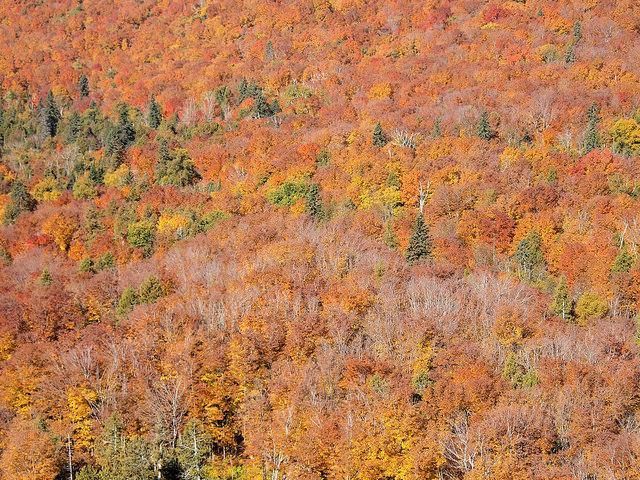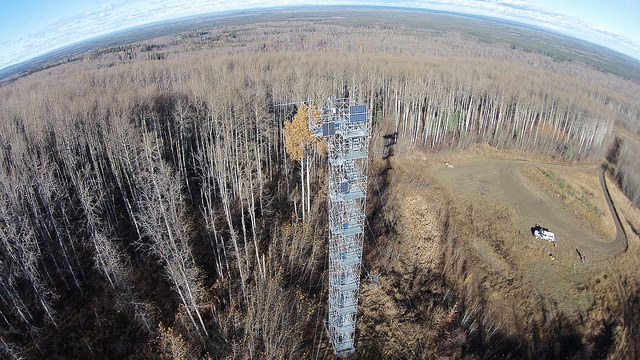Forests are diverse and fascinating ecological communities. They range from the luxuriant rainforests of the tropics, where the warm, wet and stable conditions encourage enormous plant and insect biodiversity, to the biologically hardy but impoverished forests of the boreal regions. In between, there are temperate deciduous and coniferous forests and mixed and broad-leaved evergreen forests. These include the Eucalyptus forests of Australia. In some countries they are protected and well managed but in others economic pressures, and those associated with growing human populations, are bringing about their destruction.
Forests are important for their aesthetic, ecological, and direct economic values, and because they absorb around 20% of the carbon dioxide that modern human activities emit into the atmosphere. (The oceans absorb about 30%.) If we are to manage forests, assess their economic value, evaluate whether the changes taking place in them are sustainable, and improve our estimates of the amount of carbon dioxide they are likely to absorb or emit, we need to know the mass of material in them. We also need to know how fast they are growing.
So the business of modelling forests is concerned with determining the amount of material in them – their biomass – and their growth rates. The models we use, like all mathematical models, are sets of equations that describe how we think forests grow. We provide them with input data, press the buttons on the computers and out come estimates of forest biomass and growth rates that can be mapped and tabulated and used in decision making.
The question that has to be answered is: how do we develop and test such models?
Conventional estimates of the amount of wood in a forest, and how fast it’s growing, are based on laborious, time consuming and expensive measurements. Standard-sized plots, which are necessarily rather small, are located across selected areas, taking pains to sample the variations caused by differences in soil type and topography. The dimensions of all the trees in those plots are measured. Equations must be developed for each species to convert the diameters and heights of the trees to wood volume. Biomass and carbon content are calculated using knowledge of wood density. As you can imagine, for complex natural forests, with a number of tree species and a range of unhelpful tree shapes, it can be difficult to get accurate values. Furthermore, although vast amounts of work have been done all over the world in forest biometrics, only a tiny fraction of the world’s forests has been sampled.
However, we can now estimate forest mass and growth rates from measurements made by some of the wonderful range of earth-observing satellites carrying all sorts of instruments in various orbits that provide complete coverage of our earth. These instruments continuously record enormous amounts of information in digital form. They include the instrument called LiDAR — which is the acronym for light detecting and ranging — from which laser beams are projected directly downwards. The beams bounce back to receivers with intensities that vary depending on the amount of foliage they strike, or on whether they hit gaps in the canopy. The differences between reflections from the top of the canopy and out of gaps provide estimates of forest height.
Radar, projected both sideways and downwards, can provide an accurate picture of the three-dimensional structure of forests. The return signals from radar of different frequencies reflect differences in the size of objects in their pathway. Small objects like leaves return higher frequency waves. Larger objects, such as tree trunks, reflect lower frequencies. Combining all this with data from lidar, it becomes possible to estimate the above-ground biomass, and hence the carbon content, of the forest stands.
To calibrate these satellite-derived estimates of tree heights and biomass, and test their accuracy, research in various places around the world is comparing them with conventional, ground-based measurements of the type I outlined earlier. The areas where measurements have been made on the ground are identified by what the remote sensing people call georeferencing – made much easier nowadays with GPS. Agreement between directly measured and satellite-derived estimates of forest mass is generally excellent.
Therefore, because the forest biomass in small areas can be accurately estimated from space, we can confidently use satellite measurements to estimate it for any area of the earth.
The next question is: what about growth rates?
On the basis of what we know about tree physiology and growth from thousands of measurements by scientists all over the world, over many years, we can construct models that allow us to calculate how fast forests are growing. For these we need the right input data, which we can either collect on the ground or get from satellite measurements.
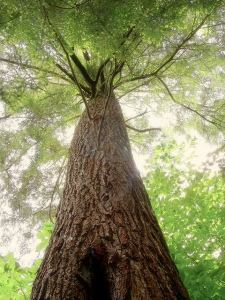 Old-growth hemlock in Allegheny National Forest, New York. Photo by Nicholas A. Tonelli, used under Creative Commons licensing.
We know that plants capture carbon dioxide through the process of photosynthesis, which converts carbon dioxide into carbohydrates. Photosynthesis is driven by radiant energy from the sun, absorbed by foliage. Some satellites provide estimates of cloud cover and from these, and the date and latitude, we can calculate the amount of solar radiation reaching the earth at any location on any day. Now, if we know how much foliage a forest is carrying, and something about the photosynthetic characteristics of that foliage, we can calculate how much solar energy the forest is absorbing and therefore how fast it is capturing carbon dioxide and how fast it is growing. Rates of growth are also affected by temperatures.
There are instruments on satellites that monitor the radiation reflected from surfaces in the visible and near-infra-red wavebands. The amount of foliage carried by vegetation in any pixel can be estimated from the reflectance ratios in different wavebands. The optics in satellite sensors can also indicate differences in the greenness of the leaves, in the same way that our eyes can detect those differences. Conventional physiological research has shown that leaf greenness can be equated with different nitrogen content in the leaves, which is associated with changes in photosynthetic capacity. The water status of forests – that is, whether they are well-watered or suffering from drought – is also indicated by the reflective properties of the leaves, so the development of drought, which affects the uptake of carbon dioxide by vegetation, can be identified from sequential scans and factored into estimates of photosynthesis rates.
So satellite measurements allow us to estimate the amount of foliage per unit ground area. They provide data on solar radiation and allow us to keep track of changes in greenness, and of indices of plant water status. Land surface temperatures can be estimated from their emissions of long-wave radiation. Putting all this information into our models, and integrating over seasons, we can calculate how much carbon dioxide has been fixed by the forest and used for above-ground and below-ground growth.
The obvious question that now has to be answered is: what evidence do we have that these modeled estimates of forest growth rates, based on satellite measurements, are correct? Do they accurately reflect reality?
To estimate growth rates from conventional forest biometrics the whole on-ground measurement exercise has to be repeated at intervals. These are usually a few years. Growth is then calculated as the difference between sequential sets of measurements, but the uncertainty in the results is considerable. Also, because soils, topography and microclimate all vary, the results are not transportable: that means you can’t, with any confidence, apply estimates of growth rates obtained from one forest region – or even one stand – to another. And the growth of trees is determined by weather, acting on physiological processes, so even if the forest is undisturbed we can’t assume that the growth rates determined over some interval will apply over the next one – particularly if the climate is changing. Finally, when there is a disturbance, caused by harvesting or fire or storm or insect attack, there’s no way, on the basis of conventional measurements, that you can predict with any confidence how the forest is going to recover.
Despite all that, areas for which good biometrics data exist serve as benchmarks against which modelled estimates of forest biomass and growth, derived from satellite measurements, can be compared. Many such comparisons have been made. The satellite-derived estimates are usually within the error of the ground-based measurements.
We can also test models against direct measurements of the rate of carbon dioxide capture by forests.
The rate of exchange of carbon dioxide between forests and the atmosphere, and the flow of water vapor into the atmosphere from forests, can be measured continuously using sophisticated instruments placed on towers situated above different types of vegetation. The towers have to be placed in quite large areas – a square kilometer or more – with uniform topography covered by forest of uniform age and composition. The difference between the downward flow of carbon dioxide because of uptake by photosynthesis during the day, and the upward flow because of respiration, at night – gives a direct measure of the rate of carbon capture by photosynthesis, and hence forest growth rates. Around the world, hundreds of these ‘flux’ towers, as they are called, have been installed in different types of forest. They provide the ‘gold standard’ against which to compare our models. We have seven of them over forests in Australia, covering tropical rainforest and several types of eucalyptus.
There have been many comparisons between measurements of forest photosynthesis, made from flux towers over days, weeks and seasons, and estimates derived from models using satellite measurements of forest structure, foliage area, radiation interception and foliage condition, associated with the area round the towers. The results indicate that the models can be used with confidence to predict the rates at which forests capture carbon dioxide and convert it into carbohydrates.
So the evidence from two entirely independent techniques indicates that we can satisfactorily model forest growth rates from measurements made in space.
Old-growth hemlock in Allegheny National Forest, New York. Photo by Nicholas A. Tonelli, used under Creative Commons licensing.
We know that plants capture carbon dioxide through the process of photosynthesis, which converts carbon dioxide into carbohydrates. Photosynthesis is driven by radiant energy from the sun, absorbed by foliage. Some satellites provide estimates of cloud cover and from these, and the date and latitude, we can calculate the amount of solar radiation reaching the earth at any location on any day. Now, if we know how much foliage a forest is carrying, and something about the photosynthetic characteristics of that foliage, we can calculate how much solar energy the forest is absorbing and therefore how fast it is capturing carbon dioxide and how fast it is growing. Rates of growth are also affected by temperatures.
There are instruments on satellites that monitor the radiation reflected from surfaces in the visible and near-infra-red wavebands. The amount of foliage carried by vegetation in any pixel can be estimated from the reflectance ratios in different wavebands. The optics in satellite sensors can also indicate differences in the greenness of the leaves, in the same way that our eyes can detect those differences. Conventional physiological research has shown that leaf greenness can be equated with different nitrogen content in the leaves, which is associated with changes in photosynthetic capacity. The water status of forests – that is, whether they are well-watered or suffering from drought – is also indicated by the reflective properties of the leaves, so the development of drought, which affects the uptake of carbon dioxide by vegetation, can be identified from sequential scans and factored into estimates of photosynthesis rates.
So satellite measurements allow us to estimate the amount of foliage per unit ground area. They provide data on solar radiation and allow us to keep track of changes in greenness, and of indices of plant water status. Land surface temperatures can be estimated from their emissions of long-wave radiation. Putting all this information into our models, and integrating over seasons, we can calculate how much carbon dioxide has been fixed by the forest and used for above-ground and below-ground growth.
The obvious question that now has to be answered is: what evidence do we have that these modeled estimates of forest growth rates, based on satellite measurements, are correct? Do they accurately reflect reality?
To estimate growth rates from conventional forest biometrics the whole on-ground measurement exercise has to be repeated at intervals. These are usually a few years. Growth is then calculated as the difference between sequential sets of measurements, but the uncertainty in the results is considerable. Also, because soils, topography and microclimate all vary, the results are not transportable: that means you can’t, with any confidence, apply estimates of growth rates obtained from one forest region – or even one stand – to another. And the growth of trees is determined by weather, acting on physiological processes, so even if the forest is undisturbed we can’t assume that the growth rates determined over some interval will apply over the next one – particularly if the climate is changing. Finally, when there is a disturbance, caused by harvesting or fire or storm or insect attack, there’s no way, on the basis of conventional measurements, that you can predict with any confidence how the forest is going to recover.
Despite all that, areas for which good biometrics data exist serve as benchmarks against which modelled estimates of forest biomass and growth, derived from satellite measurements, can be compared. Many such comparisons have been made. The satellite-derived estimates are usually within the error of the ground-based measurements.
We can also test models against direct measurements of the rate of carbon dioxide capture by forests.
The rate of exchange of carbon dioxide between forests and the atmosphere, and the flow of water vapor into the atmosphere from forests, can be measured continuously using sophisticated instruments placed on towers situated above different types of vegetation. The towers have to be placed in quite large areas – a square kilometer or more – with uniform topography covered by forest of uniform age and composition. The difference between the downward flow of carbon dioxide because of uptake by photosynthesis during the day, and the upward flow because of respiration, at night – gives a direct measure of the rate of carbon capture by photosynthesis, and hence forest growth rates. Around the world, hundreds of these ‘flux’ towers, as they are called, have been installed in different types of forest. They provide the ‘gold standard’ against which to compare our models. We have seven of them over forests in Australia, covering tropical rainforest and several types of eucalyptus.
There have been many comparisons between measurements of forest photosynthesis, made from flux towers over days, weeks and seasons, and estimates derived from models using satellite measurements of forest structure, foliage area, radiation interception and foliage condition, associated with the area round the towers. The results indicate that the models can be used with confidence to predict the rates at which forests capture carbon dioxide and convert it into carbohydrates.
So the evidence from two entirely independent techniques indicates that we can satisfactorily model forest growth rates from measurements made in space.
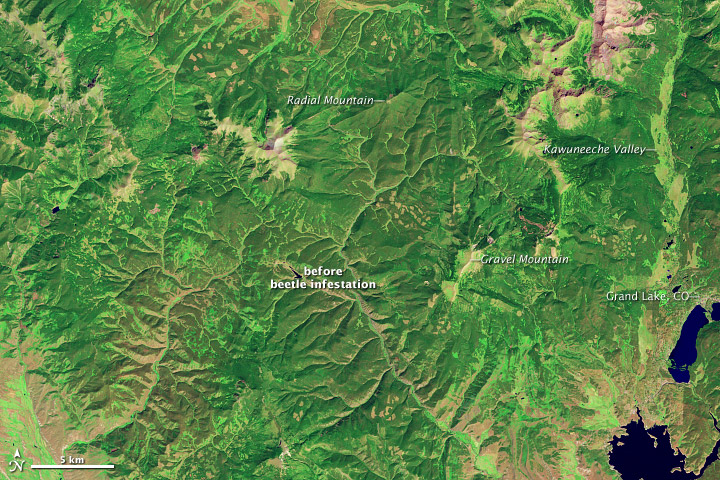 Landsat image of lodgepole pine forests near Grand Lake, Colorado, in September 2005. Photo courtesy of NASA.
Landsat image of lodgepole pine forests near Grand Lake, Colorado, in September 2005. Photo courtesy of NASA.
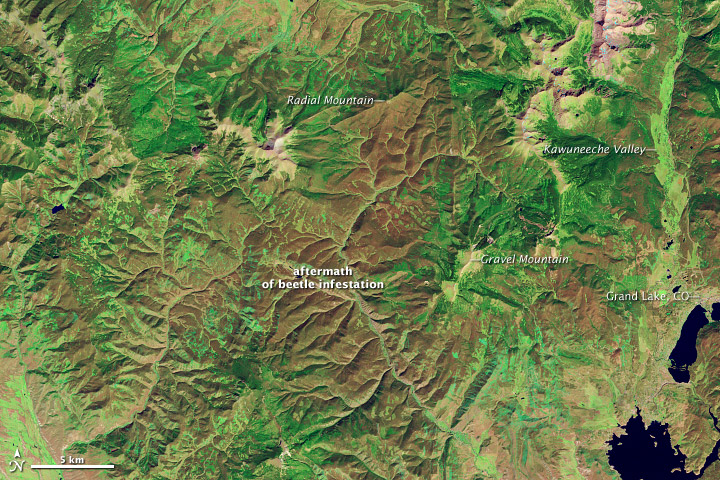 The same Colorado forest in September 2011 after an infestation of pine bark beetles. Photo courtesy of NASA.
And we can do more. Forests are disturbed and damaged by logging, wildfires, insect attacks, or climate change. The remarkable array of sensors on earth-observing satellites allows us to identify these disturbances, and the areas affected across the whole globe. We can monitor, over time, the recovery – or progressive degradation – of the forests. To identify the effects of climate change we need models that allow us to evaluate the importance of extended droughts or increasing temperatures. We also need to evaluate the effects of pollutants or other factors that change the structure and productivity of forests. The ubiquitous satellites above us provide us with the information we need to do all this.
The same Colorado forest in September 2011 after an infestation of pine bark beetles. Photo courtesy of NASA.
And we can do more. Forests are disturbed and damaged by logging, wildfires, insect attacks, or climate change. The remarkable array of sensors on earth-observing satellites allows us to identify these disturbances, and the areas affected across the whole globe. We can monitor, over time, the recovery – or progressive degradation – of the forests. To identify the effects of climate change we need models that allow us to evaluate the importance of extended droughts or increasing temperatures. We also need to evaluate the effects of pollutants or other factors that change the structure and productivity of forests. The ubiquitous satellites above us provide us with the information we need to do all this.
 Old-growth hemlock in Allegheny National Forest, New York. Photo by Nicholas A. Tonelli, used under Creative Commons licensing.
Old-growth hemlock in Allegheny National Forest, New York. Photo by Nicholas A. Tonelli, used under Creative Commons licensing. Landsat image of lodgepole pine forests near Grand Lake, Colorado, in September 2005. Photo courtesy of NASA.
Landsat image of lodgepole pine forests near Grand Lake, Colorado, in September 2005. Photo courtesy of NASA. The same Colorado forest in September 2011 after an infestation of pine bark beetles. Photo courtesy of NASA.
The same Colorado forest in September 2011 after an infestation of pine bark beetles. Photo courtesy of NASA.

